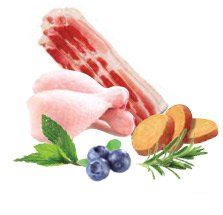Several years ago a new trend started in pet food. Some pet food companies wanted to advertise that their food is made using "human grade" ingredients. Pet food had always been made with "feed grade" ingredients.
What's the difference? "Human grade" sounds like what it is. Fit for human consumption. Although, technically, there is no legal definition for this term. "Feed grade" means that the food cannot be legally sold as food for humans. Up until this time, dog food was for dogs. Cat food was for cats. And people food was for, well, people.
 Your pets are a part of your family. So, you want to feed them the best food possible. You may like the idea of feeding your pet something that you could eat yourself. But when it comes to pet food, what does "human grade" really mean? Does a food labeled "made with human-grade ingredients" mean the food is better? What, if any difference does this mean for the health of your dog and cat?
Your pets are a part of your family. So, you want to feed them the best food possible. You may like the idea of feeding your pet something that you could eat yourself. But when it comes to pet food, what does "human grade" really mean? Does a food labeled "made with human-grade ingredients" mean the food is better? What, if any difference does this mean for the health of your dog and cat?
Food is either fit for human consumption or it is not. In order for a pet food to be labeled human grade, all ingredients in the final product must be approved for people to eat. Very few pet food companies can make this claim.
Human foods and pet foods are regulated by the FDA (Food and Drug Administration) and USDA (United States Department of Agriculture). For a product to be considered human grade it must be made in a USDA inspected facility and pass USDA inspection. So, if a pet food is made using human grade ingredients, but is manufactured in a facility that does not produce food exclusively for people, it is not human grade. Any pet food that labels itself "human grade" but does not meet these standards is guilty of misbranding the product.
What is the difference between human grade and feed grade? Feed grade is used in pet foods. Feed grade means that it cannot legally be sold as human food. One of the reasons is that the finished product may contain by-products.
By-products are parts of a slaughtered animal that are not eaten by people in this country. There has been misinformation surrounding what ingredients by-products can include. By-products are mostly internal organs, which are not only eaten in other countries but are considered delicacies! Despite having received some bad press over the last few years, by-products do not include hair, hooves, horns, hide trimmings, manure, or intestinal contents. By-products also do not include items swept up off the floor.
The quality of by-products varies greatly. Many have more nutritional value than meat. Often, a pet food that uses by-products can be nutritionally superior to one that claims to use"human grade meat". So, it is important to buy pet food from manufacturers that you trust. You should choose one that has very strict quality control standards, and is able to tell you where their ingredients come from.
Very recently the FDA announced that it would no longer verify human grade ingredients in pet food. This is being left up to individual states. It will now be the state's responsibility to verify that claims of human grade ingredients are valid. This is sure to cause more confusion for people who just want to know what is in their pet food. Of course, only time will tell!








